Introduction:
One of our ancestors wanted to separate two areas, so they thought of building a wall. All types of walls are made to protect, keep people out, or defend. Building a building on pillars and walls is a familiar idea. Even though the building elements have changed from the past to the present, the goal is still the same. There was a time when walls were built with dirt and trash using certain methods. Then came the stone wall, and the pieces are still being put together in new ways. Every day, different types of walls take on new forms because of changes and improvements.
What is a Wall?
A wall is a vertical structure, usually made of brick, concrete, or stone, that serves as a physical barrier or divider between spaces. Walls can be found in various settings, including residential, commercial, and industrial buildings, and outdoor environments, such as gardens and parks. In addition to providing a physical barrier, walls can offer security, privacy, and insulation from noise and weather. They can be decorative or functional and may serve various purposes, such as defining boundaries, supporting roof structures, or providing a surface for artwork or signage.
The design and construction of a wall can vary greatly depending on its purpose, location, and the materials used. Walls may be load-bearing or non-load-bearing, incorporating features such as windows, doors, and decorative elements. The history of walls can be traced back to ancient civilizations, where they were used for defensive purposes and have since evolved to become an integral part of modern architecture and design.
Purpose of the Wall:
The purpose of a wall can vary depending on the context in which it is built. Here are a few examples:
1. Security: Walls can be built for security purposes, to prevent unauthorized access, or to protect people or property from external threats.
2. Privacy: Walls can also be built to create a sense of privacy, such as walls around homes or gardens.
3. Boundary marking: Walls can be built to mark a boundary between different properties or territories.
4. Noise reduction: Walls can be built to reduce noise levels, such as in soundproof studios or along highways to reduce traffic noise.
5. Retaining structures: Walls can retain soil or other materials, such as in a garden or construction sites.
6. Decorative: Walls such as murals or mosaics can also be built for decorative purposes.
7. Symbolic: Walls can be built for symbolic reasons, such as the Great Wall of China, which was built to signify the strength and power of the Chinese empire.
Types of Wall Used in Construction:
1. Load Bearing Wall:
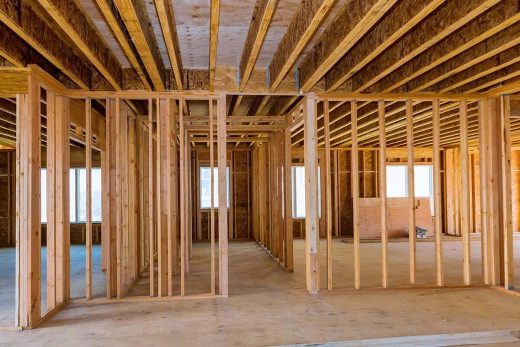
Fig1; Load Bearing Wall
Courtesy: familyhandyman.com
A load-bearing wall also called a bearing wall supports the roof and upper floors above it. The building would collapse without these walls, which distribute weight to the base. Load-bearing walls usually contain concrete, masonry, or heavy-duty wood framing. Non-load-bearing walls, commonly known as partition walls, do not sustain the structure’s weight and can be removed without damaging the building. Before renovating a building, load-bearing walls must be identified to avoid structural issues.
2. Non-Load Bearing Wall:
A non-load-bearing inner wall does not support the building above it. It is called a partition wall because it divides a building rather than supporting it. Walls of plasterboard, plaster, or wood framing can be relocated or removed without impacting the building’s stability. Non-load-bearing walls can be customized to divide a space into rooms, offices, or storage areas. They can also limit sound transfer and give seclusion. Non-load-bearing walls must be appropriately installed to ensure safety and stability. When installing or removing walls in a building, consult a contractor or engineer.
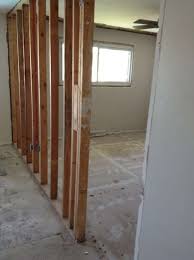
Fig2; Non-Load Bearing Wall
Courtesy: orlandi.com.au
3. Precast Wall:
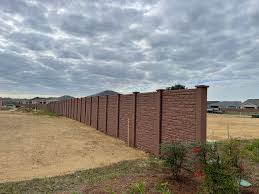
Fig3; Precast Wall
Courtesy: permacastwalls.com
A precast wall is a concrete wall manufactured in a factory or precast yard and then transported to the construction site for installation. The wall panels are typically made by casting concrete into molds or forms, which can be customized to create different shapes, sizes, textures, and finishes. Precast walls construct buildings, bridges, tunnels, and other structures. They offer several advantages over traditional cast-in-place concrete walls, including faster installation, higher quality control, reduced labor costs, and improved durability and resilience.
Precast walls can be designed to meet various structural, thermal, acoustic, and aesthetic requirements. They can be reinforced with steel or fiber reinforcement, insulated with foam or other materials, and finished with various coatings or treatments to enhance their appearance and performance.
4) Masonry Wall:
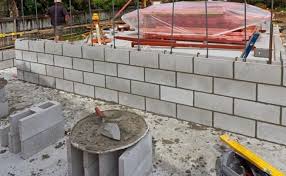
Fig4; Precast Wall
Courtesy: permacastwalls.com
Brick masonry walls are built with mortar bricks in a pattern. The residential, commercial, and industrial building uses brick walls, which can be load-bearing. A brick masonry wall requires foundation preparation, layout, mortar mixing and application, and bricklaying. The weight of the wall is distributed equally, and stability is provided by the bond between the bricks. Brick masonry walls are durable and attractive. They are fire-resistant, insulating, and low-maintenance. Brick walls take longer and cost more to build.
5) Retaining Wall:
A retaining wall is a structure that holds soil or other materials in a sloped or uneven terrain. It is used in landscaping and construction to stabilize slopes, prevent erosion, create level building sites, and improve outdoor environments. Concrete blocks poured concrete, stone, brick, timber, or gabion baskets filled with rocks can be used to build retaining walls. The design and construction of a retaining wall depend on various criteria, including the wall’s height and width, the type of soil or material to be held, drainage requirements, and the soil’s load-bearing capacity.
Retaining walls can be either gravity walls, which rely on their weight and the friction between the wall and the soil to resist the pressure of the retained material, or reinforced walls, which use steel bars or mesh and concrete to add tensile strength and improve stability. Proper drainage and construction techniques ensure a retaining wall’s long-term durability and effectiveness.
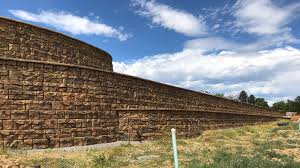
Fig5; Retaining Wall
Courtesy: slatonbros.com
6) Shear Wall:
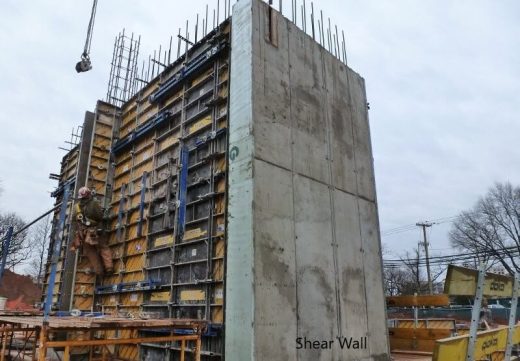
Fig6; Shear Wall
Courtesy: slatonbros.com
Shear walls in buildings resist wind and seismic stresses. Reinforced concrete, masonry, or wood shear walls carry horizontal stresses to a building’s base. They’re frequently in a building’s core or perimeter and connected to its floor and roof systems. Shear walls resist lateral stresses through bending, tension, and compression. The design of shear walls involves considering various factors, such as the building’s location, height, occupancy type, and expected loads. It is important to ensure that the shear walls are properly anchored to the foundation and that the connections between the walls and other building elements are strong enough to transfer the lateral loads.
7. Rubble Stone Masonry Wall: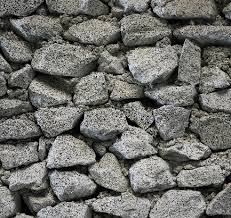
Fig7: Rubble Stone Masonry Wall
Courtesy: sciencedirectassets.co
A rubble stone masonry wall is constructed of irregularly-shaped stones typically obtained from a quarry or field. The stones are not cut or dressed to uniform sizes and shapes but are instead used in their natural form. A rubble stone masonry wall is built by laying stones of varying sizes and shapes in courses held together with mortar. The mortar is typically a mixture of sand, cement, and water. The stones are laid in a pattern that creates a stable structure, with the larger stones at the base of the wall and smaller stones towards the top.
8) Parapet Wall:
A parapet wall is a low wall that runs along the edge of a roof, balcony, terrace, or bridge, typically no higher than waist height. It is designed to provide a barrier that prevents people from falling off the edge, as well as to provide a decorative element to the structure. Parapet walls can be made of various materials, including brick, stone, concrete, and metal. They may also feature openings or decorative designs, such as balustrades or cornices. In addition to their primary function of providing safety, parapet walls can provide insulation and soundproofing to the building and serve as a platform for rooftop installations such as solar panels or air conditioning units.
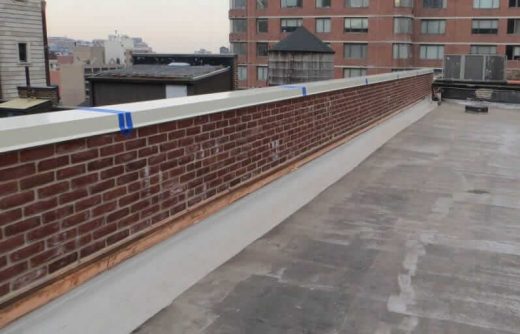
Fig8: Parapet Wall
Courtesy: structuralguide.com
9) Core Wall:
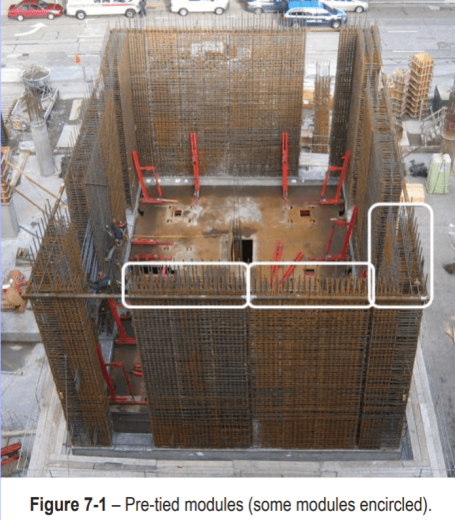
Fig9: Core Wall
Courtesy: eng-tips.com
A core wall is a structural element used in building construction to strengthen and stabilize a building’s frame. It is typically reinforced concrete and is a vertical load-bearing member extending from the foundation to the roof. The core wall is placed at the center of the building and serves as a backbone for the structure. The core wall is designed to resist the lateral loads caused by wind or earthquakes and to distribute the vertical loads from the building’s weight to the foundation. The placement and size of the core wall depend on the building’s height, shape, and function.
10) Cavity Wall:
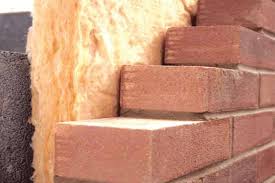
Fig10: Cavity Wall
Courtesy: cosyhomesoxfordshire.org
A cavity wall is a type of wall construction that consists of two layers (or leaves) of masonry, usually brick or block. The two leaves are separated by a cavity, typically 50-100mm wide, and designed to prevent water from penetrating the wall and reaching the inner leaf. The cavity acts as a barrier against moisture and helps to prevent the spread of dampness to the interior of the building. It also provides a space for insulation to be installed, which can improve the energy efficiency of the building. Cavity walls are commonly used in modern construction and must comply with building regulations in many countries. They are often preferred over solid walls, as they are more resistant to water penetration and can provide better thermal insulation.
11) Boundary Wall:
A boundary wall is a wall or fence that marks the edge or limits of a property. It is typically constructed to provide privacy and security and prevent unauthorized property entry. Boundary walls can be made from various materials, including brick, concrete, wood, and metal. In some cases, they may be required by local laws or regulations, particularly for commercial or industrial properties. The height and design of a boundary wall can vary depending on its purpose, location, and local building codes.
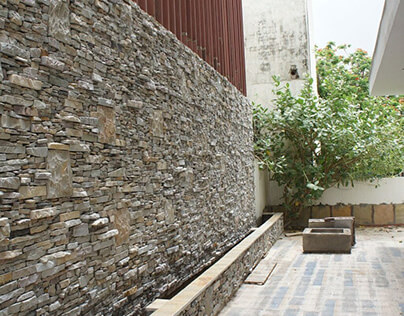 Fig11: Boundary Wall
Fig11: Boundary Wall
Courtesy: behance.net
12) Reinforced Brick Wall:
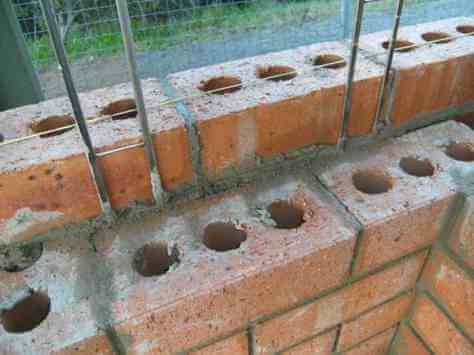
Fig11: Reinforced Brick Wall
Courtesy: civiconcept.com
Bricks are used to build a reinforced brick wall, strengthened with rebar. Reinforcement strengthens the wall, especially in locations with significant wind loads or seismic activity. The bars are positioned at particular intervals vertically and horizontally throughout the wall, according to design and engineering criteria. Bricks are put around the reinforcement, and mortar holds everything together. Reinforced brick walls are utilized in commercial, industrial, and residential construction for retaining walls, garden walls, and other constructions. They are noted for their durability, strength, and resilience to weather and other environmental variables.
Conclusion:
Walls can have various functions, such as providing privacy, security, noise reduction, insulation, or protection from weather and environmental conditions. They can also have symbolic or cultural significance, such as the Great Wall of China or the Western Wall in Jerusalem. In general, walls can be seen as a physical barrier that separates one area from another. Depending on their purpose, they can be simple or complex, plain or ornate, and vary greatly in size, shape, and design.
References:
1. V. (2021, April 13). Types of Walls in Building Construction – Viya Constructions. Viya Constructions. https://viyaconstructions.com/types-of-walls-in-building-construction/
2. Worst, R. (2022, September 18). 12 Types of Walls Used for Interior & Exterior Construction – Worst Room. Worst Room. https://worstroom.com/types-of-walls/
3. Wall types. (n.d.). Wall Types – Designing Buildings. https://www.designingbuildings.co.uk/wiki/Wall_types
4. Different Types of Walls in Construction | Types of Wall Design. (n.d.). Different Types of Walls in Construction | Types of Wall Design. https://www.constructioncost.co/types-of-walls.html
5. What are the Types of walls used in construction? (n.d.). What Are the Types of Walls Used in Construction? https://www.getpowerplay.in/blog/what-are-the-types-of-walls-used-in-construction
6. Adegbenro, A. (2022, January 13). 10 Different Types of Walls Used in Construction. A Soothing Living. https://asoothingliving.com/different-types-of-walls/
If you have a query, you can ask a question here.


